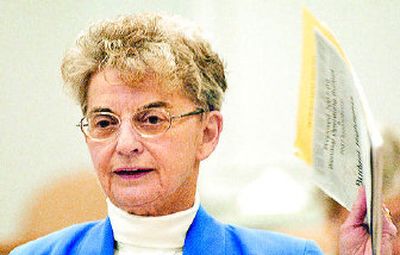House proposes budget plan

OLYMPIA – Millions of dollars to train first-year medical and dental students in Spokane. Hundreds of thousands of dollars to create an online inventory of 200,000 historic photographs stored in a Spokane museum. Millions of dollars for research – and more students – at Eastern Washington University and Washington State University.
Those are among the items in a two-year, $29.8 billion operating budget proposed Tuesday by the House of Representatives. More than three quarters of that money would be spent on public schools and human services.
“This budget is focused on children and families,” said Rep. Helen Sommers, D-Seattle, the longtime chief budget writer for the House.
“We are really now investing in our future,” said Rep. Lynn Kessler, D-Hoquiam.
The budget is similar to Gov. Chris Gregoire’s proposal in December. The third and final proposal will come from the state Senate next week, after which lawmakers will hash out a final compromise version for approval next month.
One local surprise in the budget was a provision that would transfer all state funding for the Spokane Intercollegiate Research and Technology Institute to the state Department of Community, Trade and Economic Development. SIRTI would still exist with the same number of staff and budget, but instead of being a separate state entity, it would answer to the department. That’s how SIRTI was originally set up. It changed to a standalone state agency in 2001, executive director Kim Zentz said, but the law was never changed to reflect that.
“I strongly prefer that SIRTI be directly accountable to the Legislature, citizens and companies we serve,” said Zentz.
The House’s top Republican on the budget committee blasted the Democrat-written proposal, calling it far too extravagant.
“This budget is like the governor’s in that both would turn a $2 billion surplus into a $2 billion deficit within two to three years,” said Rep. Gary Alexander, R-Olympia. “…You’d never know the economy is cooling, the way this budget spends.”
Like most state budgets, the biggest slice of the pie – more than 41 percent – would go to public schools. Another 36 percent would go to human services like health care, social service programs and prisons. The other major slice is higher education: 11 percent.
Not everyone was happy with the spending plan, however. Charles Hasse, president of the Washington Education Association, said lawmakers are missing a critical chance to significantly boost school funding. For $80 million, for example, he said the state could start phasing in a staff-student ratio of 17 to 1 in kindergarten through third grade.
“We think there’s tremendous opportunity being lost,” Hasse said in an interview.
Similarly, unionized health care workers said the budget falls far short of providing adequate money for nursing homes and mental health care, as well as providing health care for more people.
“It’s time to take bold action to expand access to health care for working families,” said Rachel Berkson, state council director for the Service Employees International Union.
The House plan also sets up a clash with the governor and Senate over what to do with the state’s savings. Washington is basking in a budget surplus of more than $2 billion, and all sides agree that much of that money should be set aside for future needs.
But Gregoire and the Senate want to build a moat around the money – in the form of a constitutional amendment requiring a “supermajority” vote from lawmakers to tap it. Sommers thinks it’s enough to simply leave the money in the treasury and rely on lawmakers’ common sense to stay away from the money until it’s badly needed.
The House budget also takes a pass on Gregoire’s proposal to pay for a new boot-camp-style “dropout academy” in Bremerton for failing students.
“We didn’t think we needed to start a new brick-and-mortar program,” said Kessler.
Among the things the budget would do:
“Add 3,600 state employees, mostly at colleges and prisons. (An extra $14 million for more agricultural research at Washington State University would add 60 state employees, Kessler said.)
“Add space for 8,300 new students at colleges and universities. Cost: About $100 million.
“Expand childhood vaccinations ($20 million) and children’s mental health treatment ($11 million).
“Boost payments to nursing homes ($30 million) and in-home care ($48 million).
“Expand the support network for foster children, with college scholarships ($2.5 million), medical coverage until age 21 instead of until 18 ($1.6 million), help finding housing as they leave foster care ($1 million) and allowing foster parents to sign up for state-subsidized health insurance ($2.5 million).
“Spend $11 million to rent jail cells in order to avoid releasing felons early due to prison overcrowding.
“Spend nearly $16 million to toughen penalties for car theft.
“Auto theft is out of control,” said Rep. Hans Dunshee, D-Snohomish. “We’re actually fourth in the nation in auto theft, and we want to reduce that. So we’re putting serious money into that.”